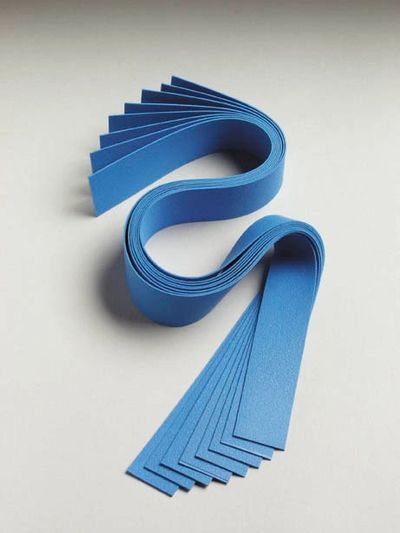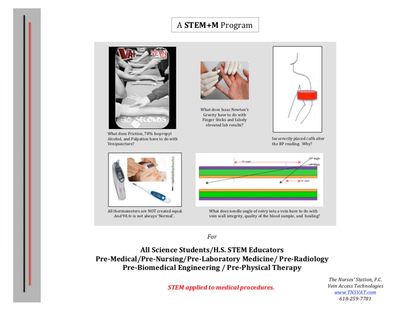STEM Lesson Plan #1

What is a tourniquet?
Merriam-Webster Dictionary definition: a device (such as a band of rubber) that checks bleeding or blood flow by compressing blood vessels.
What was the original purpose of the Tourniquet?
The tourniquet was DESIGNED to prevent bleeding to death.
First known use 1695.
When, where, and how would this tourniquet have been used to prevent bleeding to death?
- When: The 1600s.
- Where: The battlefields.
- How: Place above the bleeding body part and tighten.
How did this come to be used in Vein Access procedures?
The first form of vein access was bloodletting - with a razor cut - and some 'patients' were bleeding to death from this bloodletting procedure.
So, someone somewhere said "Hey, there's a tool for that!" That tourniquet, the one that is used on the battlefields, can be used in our barber chair.
Assignment:
- Look up the dictionary definition of "tourniquet".
- Look up the timeline (history) of the tourniquet.
- When was it first used?
- Who invented it?
- For what purpose was it invented?
- Look up the definition of 'bloodletting'.
- When did bloodletting begin?
- When was the tourniquet first used in bloodletting?

STEM LESSON #2
Bloodletting - The First Era of Vein Access
Bloodletting - The First Era of Vein Access: from the 5th-19th centuries.
According to history, two thousand or more years ago bloodletting began. Bloodletting was the first form of 'vein access'. The vein was accessed with a barber's razor initially and then with a surgeon's scalpel.
__________________________
The practice of bloodletting seemed logical when the foundation of all medical treatment was based on the four body humors: blood, phlegm, yellow bile, and black bile. Health was thought to be restored by purging, starving, vomiting, or bloodletting.
The art of bloodletting was flourishing well before Hippocrates (460 B.C.). By the middle ages, both surgeons and barbers were specializing in the bloody practice.
Barbers advertised with a red (for blood) and white (for tourniquet) striped pole. The pole itself represented the stick squeezed by the patient to dilate the veins.
Bloodletting came to the U.S. on the Mayflower. The practice reached unbelievable heights in the 18th and early 19th centuries. The first U.S. President, George Washington, died after being drained of nine pints of blood within 24 hours. Phlebotomy: The Ancient Art of Bloodletting By Graham Ford
____________________________________
And, at the height of its popularity, that primitive form of vein access involved the use of a scalpel and a tourniquet and other primitive devices.
- Was the tourniquet used to promote venous distention, to bleed more;
- was it used to prevent the venous blood flow from going up, so more would go out (the ‘damming’ effect’):
- or was it used because they feared that bleeding to death could actually occur and was, therefore, used in its truest sense – to stop bleeding?
Only vague written descriptions of the practice exist and only a general description of the thought process behind the practice can be found. But considering the absence of scientific information about the body at that time, using the tourniquet to prevent bleeding to death is the logical answer.
But what we do know for sure is that 2000 years ago, when vein access began, the medical community did not have the knowledge about anatomy and physiology, or the tool technology that we have now. We also know that in the 5th -19th centuries it was primarily a barber who did bloodletting. Barbers were not scientists, nor were they science educated. So the foundation for vein access, laid in those days, was not based upon science.
The 20th century venipuncture procedure of today was built on that 5th-19th century non-scientific foundation. And that is why there are so many venipuncture failures and all of those ccif(s).
Assignment:
- Search the internet for the History of Bloodletting.
- What is the dictionary definition of the word Phlebotomy?
- What does the Red & White barber pole actually advertise?
- Is 'bloodletting' still performed today, and for what illness? [Hint: Polycythemia Vera]
- Is the razor used anywhere in the blood collection process of today in the practice of medicine? [POC- point of care blood collection.]
STEM LESSON #3

How did the Tourniquet come to be used in today's 20th venipuncture procedures?
Recall that, originally, the tourniquet was used to prevent bleeding to death from a razor or scalpel cut. The tourniquet was used in its truest definitional sense.
And, since 'necessity if the mother of invention', Drs. Woods and Pravaz, in different parts of the world, invented the needle - the needle that is still used today in venipuncture / vein access procedures.
And when that needle was invented, and used to access a vein, and bleeding to death was no longer a reality or a concern, that tourniquet should have been 'put away', no longer used.
BUT...it just got harder to 'locate a vein' with a tiny, little, almost microscopic needle tip. [With a razor or scalpel, one could just cut a wide swath and was sure to hit a vessel or two, or more - with profuse bleeding to follow.]
And low and behold, applying a tight tourniquet over distends the vein - making it bigger - making it easier to find it with that tiny, little needle.
Or did it - make it easier to find the vein?
[How many multiple stick events still occur with
that very tightly applied tourniquet?!?!?!?]
So that explains why the tourniquet was brought forward into the 2nd vein access era. But as you just read, the tourniquet causes an OVER DISTENTION of the vein, not a true 'vein dilatation'.
Today's 20th century worker will tell you that the tourniquet is used to 'dilate a vein' - to make it easier to 'locate a vein'.
And, again, I say....
Did it - make it easier to find the vein?
How many multiple stick events still occur
with that very tightly applied tourniquet?
When the treatment bloodletting became diagnostic blood testing, that tourniquet should have been put away. And Gray's Anatomy of the Vein and Starling's Equilibrium of the Venous System should have been applied.
And that is what Vein Access Technologies did - applied STEM.
Assignment:
- Search the internet -"why is the tourniquet used in venipuncture".
- Record your findings.
- Interview medical personnel who perform venipuncture and ask why they use a tourniquet?
- Record the various answers and record the statistical analysis of the occurrence of those answers.
LESSON PLANS 4 - ......

The Remainder of the Lesson Plans
Lesson Plans 1 - 20:
Lesson Plans are even used as CE(s) -
Continuing Education programs in Medicine.
The article below is part of the CE program through MediaLab for Laboratory Medicine personnel.

The Story of Phlebotomy: A Historical perspective
BY Authors: Garland E. Pendergraph, PhD, JD, MLS(ASCP)SM, HCLD/CC(ABB) and
M. Gail Stotler, B.S.N., R.N.
Published in MediaLab - an ASCP continuing education module.
Join this STEM Project and be part of the Next Generation!
Vein Access Technologies
2 Terminal Drive, Suite 1, East Alton, Illinois 62024, United States
Copyright © 2025 Vein Access Technologies - All Rights Reserved.
Powered by GoDaddy Website Builder